Regulation of Δ6Fads2 Gene Involved in LC-PUFA Biosynthesis Subjected to Fatty Acid in Large Yellow Croaker (Larimichthys crocea) and Rainbow Trout (Oncorhynchus mykiss)
Abstract
:1. Introduction
2. Materials and Methods
2.1. Animal Studies
2.2. Fatty Acid Composition Analysis
2.3. RNA Extraction and cDNA Synthesis
2.4. Absolute Quantification PCR (AQ-PCR), RT-qPCR and Western Blotting
2.5. Primary Culture of Hepatocytes and Incubation
2.6. Genomic DNA Extraction, fads2 Promoter Cloning, and Deletion Mutant Construction
2.7. Cell Culture, Transfection, and Luciferase Reporter Assay
2.8. RNA Interference Assay
2.9. Site-Directed Mutation
2.10. Chromatin Immunoprecipitation (ChIP) Assay
2.11. Electrophoretic Mobility Shift Assay (EMSA)
2.12. Statistical Analysis
3. Results
3.1. Fatty Acid Compositions in Liver, Muscle, and Intestine of Large Yellow Croaker and Rainbow Trout
3.2. Absolute Quantitative Analysis of fads2 Expression
3.3. Relative fads2 Expression in Hepatocytes of Large Yellow Croaker and Rainbow Trout in Response to Fatty Acids
3.4. Analysis of Deletion Mutants’ Activities
3.5. Transcriptional Regulation of the fads2 Promoter by Transcription Factors
3.6. Absolute Quantitative Analysis of c/ebpα and gata3 Expression, and Relative Expression of C/EBPα Protein Level
3.7. Effects of RNA Interference on Expression of c/ebpα, gata3, and Its Potential Target Genes fads2
3.8. Site-Directed Mutation of C/EBPα and GATA3 Binding Sites
3.9. Identification of C/EBPα and GATA3 Binding Sites in the fads2 Promoter Region
4. Discussion
Supplementary Materials
Author Contributions
Funding
Institutional Review Board Statement
Informed Consent Statement
Data Availability Statement
Acknowledgments
Conflicts of Interest
Abbreviation
References
- Eilander, A.; Hundscheid, D.C.; Osendarp, S.J.; Transler, C.; Zock, P.L. Effects of n-3 long chain polyunsaturated fatty acid supplementation on visual and cognitive development throughout childhood: A review of human studies. Prostaglandins Leukot. Essent. Fat. Acids 2007, 76, 189–203. [Google Scholar] [CrossRef] [PubMed]
- Salem, N., Jr.; Litman, B.; Kim, H.; Gawrisch, K. Mechanisms of action of docosahexaenoic acid in the nervous system. Lipids 2001, 36, 945–959. [Google Scholar] [CrossRef] [PubMed] [Green Version]
- Leaf, A.; Kang, J.X. Prevention of cardiac sudden death by N-3 fatty acids: A review of the evidence. J. Intern. Med. 1996, 240, 5–12. [Google Scholar] [CrossRef] [PubMed]
- Torrejon, C.; Jung, U.J.; Deckelbaum, R.J. n-3 Fatty acids and cardiovascular disease: Actions and molecular mechanisms. Prostaglandins Leukot. Essent. Fat. Acids 2007, 77, 319–326. [Google Scholar] [CrossRef] [Green Version]
- Calder, P.C. Immunomodulation by omega-3 fatty acids. Prostaglandins Leukot. Essent. Fat. Acids 2007, 77, 327–335. [Google Scholar] [CrossRef]
- Wall, R.; Ross, R.P.; Fitzgerald, G.F.; Stanton, C. Fatty acids from fish: The anti-inflammatory potential of long-chain omega-3 fatty acids. Nutr. Rev. 2010, 68, 280–289. [Google Scholar] [CrossRef]
- Nakamura, M.T.; Cho, H.P.; Xu, J.; Tang, Z.; Clarke, S.D. Metabolism and functions of highly unsaturated fatty acids: An update. Lipids 2001, 36, 961–964. [Google Scholar] [CrossRef]
- Brenna, J.T.; Salem, N.; Sinclair, A.J.; Cunnane, S.C. α-Linolenic acid supplementation and conversion to n-3 long-chain polyunsaturated fatty acids in humans. Prostaglandins Leukot. Essent. Fat. Acids 2009, 80, 85–91. [Google Scholar] [CrossRef]
- Cowey, C.B.; Sargent, J.R. Fish Nutrition. Adv. Mar. Biol. 1972, 10, 383–494. [Google Scholar]
- Sargent, J.R.; Tocher, D.R.; Bell, J.G. The lipids. In Fish Nutrition; Elsevier: New York, NY, USA, 2003; pp. 181–257. [Google Scholar]
- Tocher, D.R. Metabolism and functions of lipids and fatty acids in teleost fish. Rev. Fish. Sci. 2003, 11, 107–184. [Google Scholar] [CrossRef]
- Nara, T.Y.; He, W.S.; Tang, C.; Clarke, S.D.; Nakamura, M.T. The E-box like sterol regulatory element mediates the suppression of human Δ-6 desaturase gene by highly unsaturated fatty acids. Biochem. Biophys. Res. Commun. 2002, 296, 111–117. [Google Scholar] [CrossRef]
- Castro, L.F.; Monroig, O.; Leaver, M.J.; Wilson, J.; Cunha, I.; Tocher, D.R. Functional desaturase Fads1 (Delta5) and Fads2 (Delta6) orthologues evolved before the origin of jawed vertebrates. PLoS ONE 2012, 7, e31950. [Google Scholar] [CrossRef] [PubMed] [Green Version]
- Guillou, H.; Zadravec, D.; Martin, P.G.P.; Jacobsson, A. The key roles of elongases and desaturases in mammalian fatty acid metabolism: Insights from transgenic mice. Prog. Lipid Res. 2010, 49, 186–199. [Google Scholar] [CrossRef] [PubMed]
- Buzzi, M.; Henderson, R.J.; Sargent, J.R. The desaturation and elongation of linolenic acid and eicosapentaenoic acid by hepatocytes and liver microsomes from rainbow trout (Oncorhynchus mykiss) fed diets containing fish oil or olive oil. Biochim. Biophys. Acta-Lipids Lipid Metab. 1996, 1299, 235. [Google Scholar] [CrossRef]
- Zuo, R.; Mai, K.; Xu, W.; Dong, X.; Ai, Q. Molecular cloning, tissue distribution and nutritional regulation of a Δ6-fatty acyl desaturase-like enzyme in large yellow croaker (Larimichthys crocea). Aquac. Res. 2016, 47, 445–459. [Google Scholar] [CrossRef]
- Xu, H.; Dong, X.; Ai, Q.; Mai, K.; Xu, W.; Zhang, Y.; Zuo, R. Regulation of tissue LC-PUFA contents, Delta6 fatty acyl desaturase (FADS2) gene expression and the methylation of the putative FADS2 gene promoter by different dietary fatty acid profiles in Japanese seabass (Lateolabrax japonicus). PLoS ONE 2014, 9, e87726. [Google Scholar]
- Li, S.; Mai, K.; Xu, W.; Yuan, Y.; Zhang, Y.; Ai, Q. Characterization, mRNA expression and regulation of Δ6 fatty acyl desaturase (FADS2) by dietary n-3 long chain polyunsaturated fatty acid (LC-PUFA) levels in grouper larvae (Epinephelus coioides). Aquaculture 2014, 434, 212–219. [Google Scholar] [CrossRef]
- Zheng, X.; Torstensen, B.E.; Tocher, D.R.; Dick, J.R.; Henderson, R.J.; Bell, J.G. Environmental and dietary influences on highly unsaturated fatty acid biosynthesis and expression of fatty acyl desaturase and elongase genes in liver of Atlantic salmon (Salmo salar). Biochim. Biophys. Acta Mol. Cell Biol. Lipids 2005, 1734, 13–24. [Google Scholar] [CrossRef]
- Seiliez, I.; Panserat, S.; Kaushik, S.; Bergot, P. Cloning, tissue distribution and nutritional regulation of a Δ6-desaturase-like enzyme in rainbow trout. Comp. Biochem. Physiol. B-Biochem. Mol. Biol. 2001, 130, 83–93. [Google Scholar] [CrossRef]
- Ramji, D.P.; Foka, P. CCAAT/enhancer-binding proteins: Structure, function and regulation. Biochem. J. 2002, 365 Pt 3, 561–575. [Google Scholar] [CrossRef] [Green Version]
- Schrem, H.; Klempnauer, J.; Borlak, J. Liver-enriched transcription factors in liver function and development. part II: The C/EBPs and D site-binding protein in cell cycle control, carcinogenesis, circadian gene regulation, liver regeneration, apoptosis, and liver-specific gene regulation. Pharmacol. Rev. 2004, 56, 291–330. [Google Scholar] [CrossRef] [PubMed] [Green Version]
- Matsubara, Y.; Sato, K.; Ishii, H.; Akiba, Y. Changes in mRNA expression of regulatory factors involved in adipocyte differentiation during fatty acid induced adipogenesis in chicken. Comp. Biochem. Physiol. A-Mol. Integr. Physiol. 2005, 141, 108–115. [Google Scholar] [CrossRef] [PubMed]
- Matsubara, Y.; Endo, T.; Kano, K. Fatty acids but not dexamethasone are essential inducers for chick adipocyte differentiation in vitro. Comp. Biochem. Physiol. A-Mol. Integr. Physiol. 2008, 151, 511–518. [Google Scholar] [CrossRef]
- Liu, D.; Mai, K.; Zhang, Y.; Xu, W.; Ai, Q. Wnt/b-catenin signaling participates in the regulation of lipogenesis in the liver of juvenile turbot (Scophthalmus maximus L.). Comp. Biochem. Physiol. B-Biochem. Mol. Biol. 2016, 191, 155–162. [Google Scholar] [CrossRef] [PubMed]
- Liu, D.; Mai, K.; Zhang, Y.; Xu, W.; Ai, Q. Tumour necrosis factor-a inhibits hepatic lipid deposition through GSK-3b/b-catenin signaling in juvenile turbot (Scophthalmus maximus L.). Gen. Comp. Endocrinol. 2016, 228, 1–8. [Google Scholar] [CrossRef] [PubMed]
- Wu, Y.; Peng, X.; Wang, D.; Chen, W.; Lin, X. Human liver fatty acid binding protein (hFABP1) gene is regulated by liver-enriched transcription factors HNF3b and C/EBPα. Biochimie 2012, 94, 384–392. [Google Scholar] [CrossRef]
- Qiao, L.; MacLean, P.S.; You, H.; Schaack, J.; Shao, J. Knocking down liver CCAAT/enhancer-binding protein a by adenovirus-transduced silent interfering ribonucleic acid improves hepatic gluconeogenesis and lipid homeostasis in db/db Mice. Endocrinology 2006, 147, 3060–3069. [Google Scholar] [CrossRef] [Green Version]
- Huo, L.; Gong, Y.; Guo, M.; Gilcrease, M.Z.; Wu, Y.; Zhang, H.; Zhang, J.; Resetkova, E.; Hunt, K.K.; Deavers, M.T. GATA-binding protein 3 enhances the utility of gross cystic disease fluid protein-15 and mammaglobin A in triple-negative breast cancer by immunohistochemistry. Histopathology 2015, 67, 245–254. [Google Scholar] [CrossRef]
- Lentjes, M.H.; Niessen, H.E.; Akiyama, Y.; de Bruïne, A.P.; Melotte, V.; van Engeland, M. The emerging role of GATA transcription factors in development and disease. Expert Rev. Mol. Med. 2016, 18, e3. [Google Scholar] [CrossRef]
- Dong, X.; Tan, P.; Cai, Z.; Xu, H.; Li, J.; Ren, W.; Xu, H.; Zuo, R.; Zhou, J.; Mai, K.; et al. Regulation of FADS2 transcription by SREBP-1 and PPAR-a influences LC-PUFA biosynthesis in fish. Sci. Rep. 2017, 7, 40024. [Google Scholar] [CrossRef]
- Li, X.; Cui, K.; Fang, W.; Chen, Q.; Xu, D.; Mai, K.; Zhang, Y.; Ai, Q. High level of dietary olive oil decreased growth, increased liver lipid deposition and induced inflammation by activating the p38 MAPK and JNK pathways in large yellow croaker (Larimichthys crocea). Fish Shellfish Immunol. 2019, 94, 157–165. [Google Scholar] [CrossRef] [PubMed]
- Li, L.; Zhao, C.P.; Hong, L.; Li, W.F.; Zhang, L.H.; Xu, D.M.; Wang, J.S.; Li, H.F. Establishment of the plasmid standard curve generation method for absolute quantification PCR. J. Agric. Biotechnol. 2011, 19, 1157–1162. [Google Scholar]
- Livak, K.J.; Schmittgen, T.D.L. Analysis of relative gene expression data using real-time quantitative PCR and the 2−ΔΔCt method. Methods 2001, 25, 402–408. [Google Scholar] [CrossRef] [PubMed]
- Liu, Z.; Gan, L.; Liu, G.; Chen, Y.; Wu, T.; Feng, F.; Sun, C. Sirt1 decreased adipose inflammation by interacting with Akt2 and inhibiting mTOR/S6K1 pathway in mice. J. Lipid Res. 2016, 57, 1373–1381. [Google Scholar] [CrossRef] [PubMed] [Green Version]
- Wang, X.; He, G.; Mai, K.; Xu, W.; Zhou, H. Differential regulation of taurine biosynthesis in rainbow trout and Japanese flounder. Sci. Rep. 2016, 6, 21231. [Google Scholar] [CrossRef] [PubMed] [Green Version]
- Dai, W.; Panserat, S.; Kaushik, S.; Terrier, F.; Plagnes-Juan, E.; Seiliez, I.; Skiba-Cassy, S. Hepatic fatty acid biosynthesis is more responsive to protein than carbohydrate in rainbow trout during acute stimulations. Am. J. Physiol.-Regul. Integr. Comp. Physiol. 2016, 310, R74–R86. [Google Scholar] [CrossRef] [Green Version]
- Ferraris, M.; Radice, S.; Catalani, P.; Francolini, M.; Marabini, L.; Chiesara, E. Early oxidative damage in primary cultured trout hepatocytes: A time course study. Aquat. Toxicol. 2002, 59, 283–296. [Google Scholar] [CrossRef]
- Segner, H. Isolation and primary culture of teleost hepatocytes. Comp. Biochem. Physiol. A-Mol. Integr. Physiol. 1998, 120, 71–81. [Google Scholar] [CrossRef]
- Li, S.; Monroig, Ó.; Wang, T.; Yuan, Y.; Carlos Navarro, J.; Hontoria, F.; Liao, K.; Tocher, D.R.; Mai, K.; Xu, W.; et al. Functional characterization and differential nutritional regulation of putative Elovl5 and Elovl4 elongases in large yellow croaker (Larimichthys crocea). Sci. Rep. 2017, 7, 2303. [Google Scholar] [CrossRef]
- Li, J.; Li, X.; Ji, R.; Xu, W.; Mai, K.; Ai, Q. The effects of linseed oil and soybean oil on fatty acid composition and Δ6Fad gene expression in liver and muscle of large yellow croaker (Larimichthys crocea). Acta Hydrobiol. Sin. 2018, 42, 232–239. [Google Scholar]
- Cook, H.W.; Mcmaster, C.R. Chapter 7 Fatty acid desaturation and chain elongation in eukaryotes. New Compr. Biochem. 2002, 36, 181–204. [Google Scholar]
- Hastings, N.; Agaba, M.; Tocher, D.R.; Leaver, M.J.; Dick, J.R.; Sargent, J.R.; Teale, A.J. A vertebrate fatty acid desaturase with Delta 5 and Delta 6 activities. Proc. Natl. Acad. Sci. USA 2001, 98, 14304–14309. [Google Scholar] [CrossRef] [PubMed] [Green Version]
- Monroig, O.; Navarro, J.C.; Tocher, D.R. Long-chain polyunsaturated fatty acids in fish: Recent advances on desaturases and elongases involved in their biosynthesis. In Proceedings of the XI International Symposium on Aquaculture, San Nicolás de los Garza, Mexico, 23–25 November 2011; pp. 257–282. [Google Scholar]
- Geay, F.; Santigosa I Culi, E.; Corporeau, C.; Boudry, P.; Dreano, Y.; Corcos, L.; Bodin, N.; Vandeputte, M.; Zambonino-Infante, J.L.; Mazurais, D.; et al. Regulation of FADS2 expression and activity in European sea bass (Dicentrarchus labrax, L.) fed a vegetable diet. Comp. Biochem. Physiol. B-Biochem. Mol. Biol. 2010, 156, 237–243. [Google Scholar] [CrossRef] [Green Version]
- Tocher, D.R.; Zheng, X.; Schlechtriem, C.; Hastings, N.; Dick, J.R.; Teale, A.J. Highly unsaturated fatty acid synthesis in marine fish: Cloning, functional characterization, and nutritional regulation of fatty acyl delta 6 desaturase of Atlantic cod (Gadus morhua L.). Lipids 2006, 41, 1003–1016. [Google Scholar] [CrossRef]
- Torstensen, B.; Tocher, D. The Effects of Fish Oil Replacement on Lipid Metabolism of Fish. In Fish Oil Replacement and Alternative Lipid Sources in Aquaculture Feeds; CRC Press: Boca Raton, FA, USA, 2010. [Google Scholar]
- Vagner, M.; Santigosa, E. Characterization and modulation of gene expression and enzymatic activity of delta-6 desaturase in teleosts: A review. Aquaculture 2011, 315, 131–143. [Google Scholar] [CrossRef]
- Almaida-Pagán, P.F.; Hernández, M.D.; García García, B.; Madrid, J.A.; De Costa, J.; Mendiola, P. Effects of total replacement of fish oil by vegetable oils on n-3 and n-6 polyunsaturated fatty acid desaturation and elongation in sharpsnout seabream (Diplodus puntazzo) hepatocytes and enterocytes. Aquaculture 2007, 272, 589–598. [Google Scholar] [CrossRef]
- Mourente, G.; Dick, J.R.; Bell, J.G.; Tocher, D.R. Effect of partial substitution of dietary fish oil by vegetable oils on desaturation and β-oxidation of [1-14C]18:3n-3 (LNA) and [1-14C]20:5n-3 (EPA) in hepatocytes and enterocytes of European sea bass (Dicentrarchus labrax L.). Aquaculture 2005, 248, 173–186. [Google Scholar] [CrossRef]
- Tocher, D.R.; Ghioni, C. Fatty acid metabolism in marine fish: Low activity of fatty acyl Δ5 desaturation in gilthead sea bream (Sparus aurata) cells. Lipids 1999, 34, 433. [Google Scholar] [CrossRef]
- Zheng, X.; Leaver, M.J.; Tocher, D.R. Long-chain polyunsaturated fatty acid synthesis in fish: Comparative analysis of Atlantic salmon (Salmo salar L.) and Atlantic cod (Gadus morhua L.) Δ6 fatty acyl desaturase gene promoters. Comp. Biochem. Physiol. B-Biochem. Mol. Biol. 2009, 154, 255–263. [Google Scholar] [CrossRef]
- Tocher, D.R.; Dick, J.R.; Macglaughlin, P.; Bell, J.G. Effect of diets enriched in Δ6 desaturated fatty acids (18:3n-6 and 18:4n-3), on growth, fatty acid composition and highly unsaturated fatty acid synthesis in two populations of Arctic charr (Salvelinus alpinus L.). Comp. Biochem. Physiol. B-Biochem. Mol. Biol. 2006, 144, 245–253. [Google Scholar] [CrossRef] [Green Version]
- Leaver, M.J.; Bautista, J.M.; Bj Rnsson, B.R.T.; J Nsson, E.; Krey, G.; Tocher, D.R.; Torstensen, B.E. Towards Fish Lipid Nutrigenomics: Current State and Prospects for Fin-Fish Aquaculture. Rev. Fish. Sci. 2008, 16, 71–92. [Google Scholar] [CrossRef] [Green Version]
- Bell, M.V.; Tocher, D.R. Biosynthesis of Polyunsaturated Fatty Acids in Aquatic Ecosystems: General Pathways and New Directions; Springer: New York, NY, USA, 2009. [Google Scholar]
- Dong, Y.; Wang, S.; Chen, J.; Zhang, Q.; Liu, Y.; You, C.; Monroig, Ó.; Tocher, D.R.; Li, Y. Hepatocyte nuclear factor 4a (HNF4a) is a transcription factor of vertebrate fatty acyl desaturase gene as identified in marine teleost Siganus canaliculatus. PLoS ONE 2016, 11, e0160361. [Google Scholar] [CrossRef] [PubMed]
- Zhang, Q.; You, C.; Liu, F.; Zhu, W.; Wang, S.; Xie, D.; Monroig, Ó.; Tocher, D.R.; Li, Y. Cloning and characterization of lxr and Srebp1, and their potential roles in regulation of LC-PUFA biosynthesis in rabbitfish Siganus canaliculatus. Lipids 2016, 51, 1051–1063. [Google Scholar] [CrossRef] [PubMed]
- Dong, Y.; Zhao, J.; Chen, J.; Wang, S.; Liu, Y.; Zhang, Q.; You, C.; Monroig, Ó.; Tocher, D.R.; Li, Y. Cloning and characterization of ∆6/∆5 fatty acyl desaturase (Fad) gene promoter in the marine teleost Siganus canaliculatus. Gene 2018, 647, 174–180. [Google Scholar] [CrossRef] [PubMed]
- Zaini, M.A.; Müller, C.; de Jong, T.V.; Ackermann, T.; Hartleben, G.; Kortman, G.; Gührs, K.; Fusetti, F.; Krämer, O.H.; Guryev, V.; et al. A p300 and SIRT1 regulated acetylation switch of C/EBPα controls mitochondrial function. Cell Rep. 2018, 22, 497–511. [Google Scholar] [CrossRef] [Green Version]
- Rosen, E.D.; Hsu, C.H.; Wang, X.; Sakai, S.; Freeman, M.W.; Gonzalez, F.J.; Spiegelman, B.M. C/EBPα induces adipogenesis through PPARgamma: A unified pathway. Genes Dev. 2002, 16, 22–26. [Google Scholar] [CrossRef] [Green Version]
- Jin, Q.; Zhang, F.; Yan, T.; Liu, Z.; Wang, C.; Ge, X.; Zhai, Q. C/EBPα regulates SIRT1 expression during adipogenesis. Cell Res. 2010, 20, 470–479. [Google Scholar] [CrossRef] [Green Version]
- Choi, S.K.; Park, S.; Jang, S.; Cho, H.H.; Lee, S.; You, S.; Kim, S.; Moon, H. Cascade regulation of PPARγ2 and C/EBPα signaling pathways by celastrol impairs adipocyte differentiation and stimulates lipolysis in 3T3-L1 adipocytes. Metabolism 2016, 65, 646–654. [Google Scholar] [CrossRef]
- Hossain, M.G.; Iwata, T.; Mizusawa, N.; Shima, S.W.N.; Okutsu, T.; Ishimoto, K.; Yoshimoto, K. Compressive force inhibits adipogenesis through COX-2-mediated down-regulation of PPARγ2 and C/EBPα. J. Biosci. Bioeng. 2010, 109, 297–303. [Google Scholar] [CrossRef]
- Pedersen, T.A. Cooperation between C/EBPα TBP/TFIIB and SWI/SNF recruiting domains is required for adipocyte differentiation. Genes Dev. 2001, 15, 3208–3216. [Google Scholar] [CrossRef] [Green Version]
- Wu, Z.; Rosen, E.D.; Brun, R.; Hauser, S.; Adelmant, G.; Troy, A.E.; McKeon, C.; Darlington, G.J.; Spiegelman, B.M. Cross-regulation of C/EBPα and PPARγ controls the transcriptional pathway of adipogenesis and insulin sensitivity. Mol. Cell 1999, 3, 151–158. [Google Scholar] [CrossRef]
- Okazaki, M.; Maeda, G.; Chiba, T.; Doi, T.; Imai, K. Identification of GATA3 binding sites in Jurkat cells. Gene 2009, 445, 17–25. [Google Scholar] [CrossRef] [PubMed]
- Wei, G.; Abraham, B.J.; Yagi, R.; Jothi, R.; Cui, K.; Sharma, S.; Narlikar, L.; Northrup, D.L.; Tang, Q.; Paul, W.E.; et al. Genome-wide analyses of transcription factor GATA3-mediated gene regulation in distinct T cell types. Immunity 2011, 35, 299–311. [Google Scholar] [CrossRef] [PubMed] [Green Version]
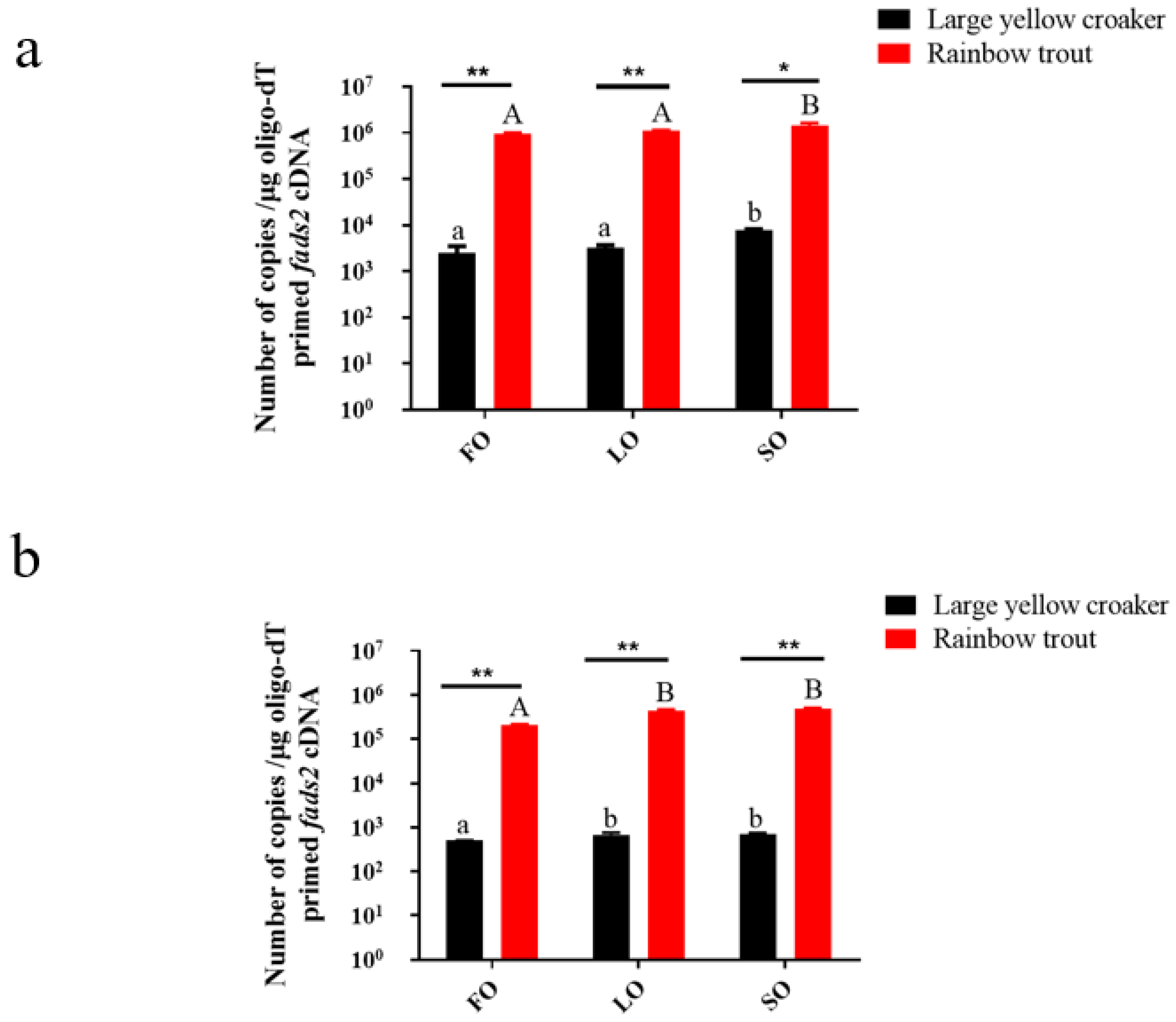
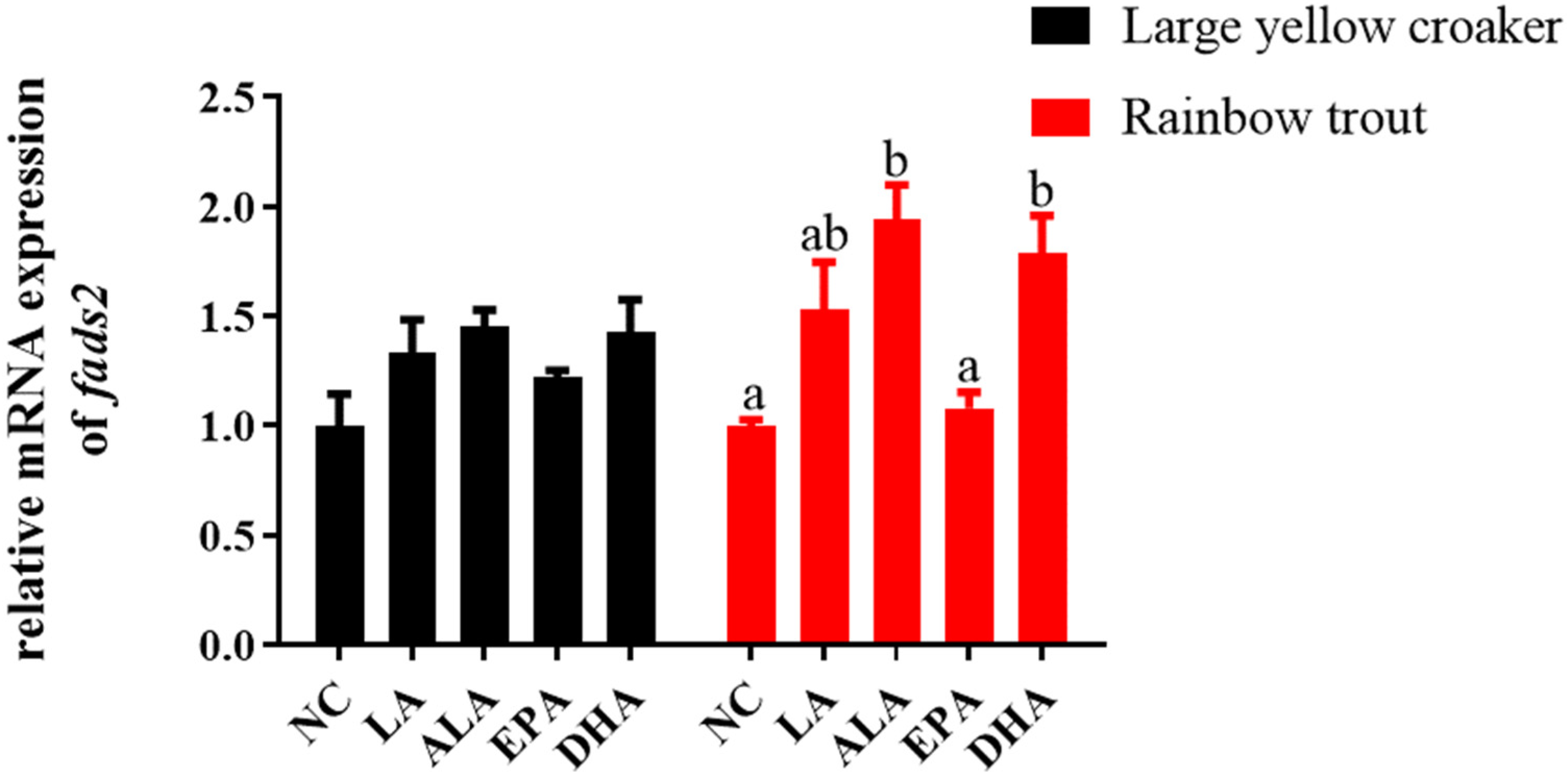
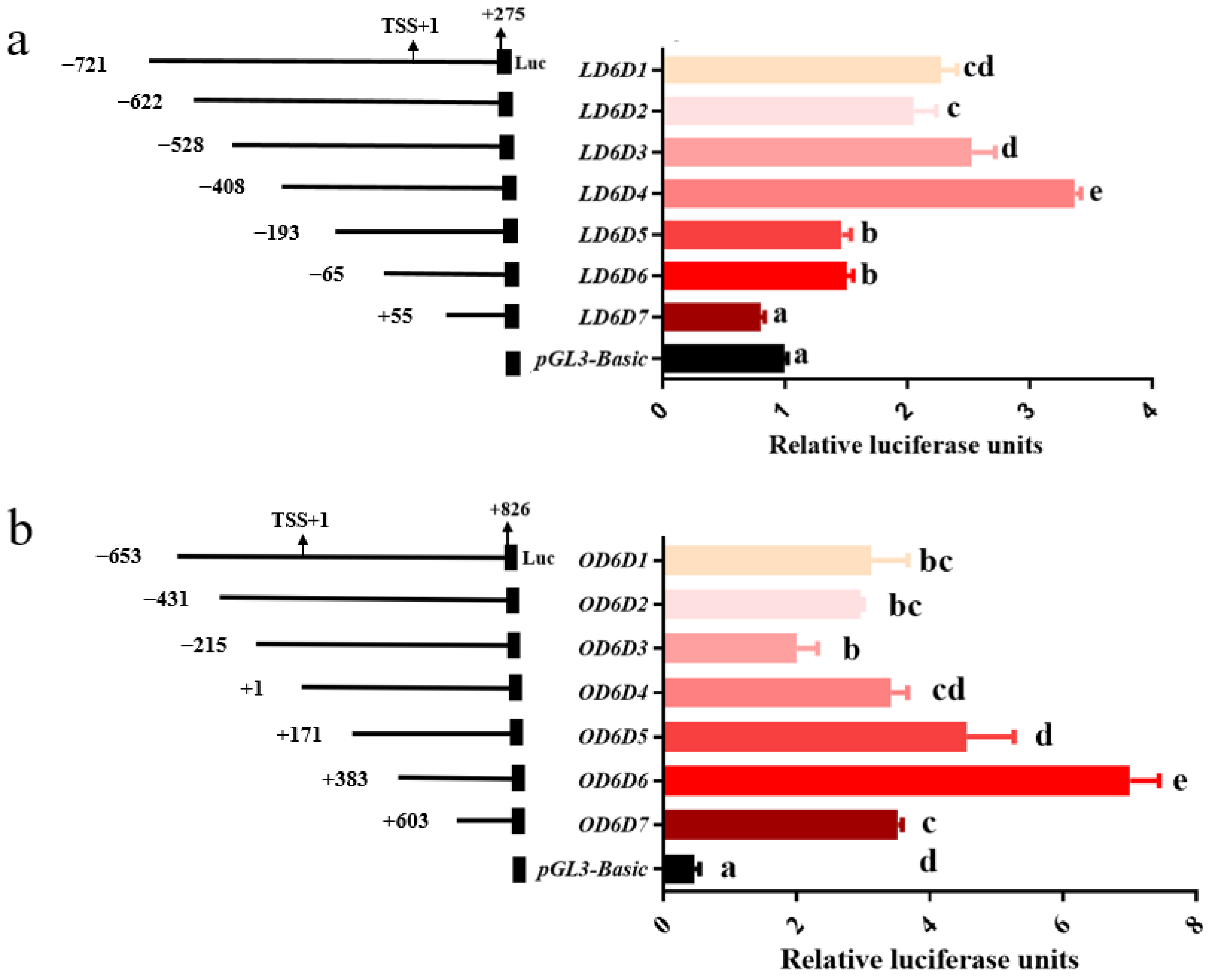
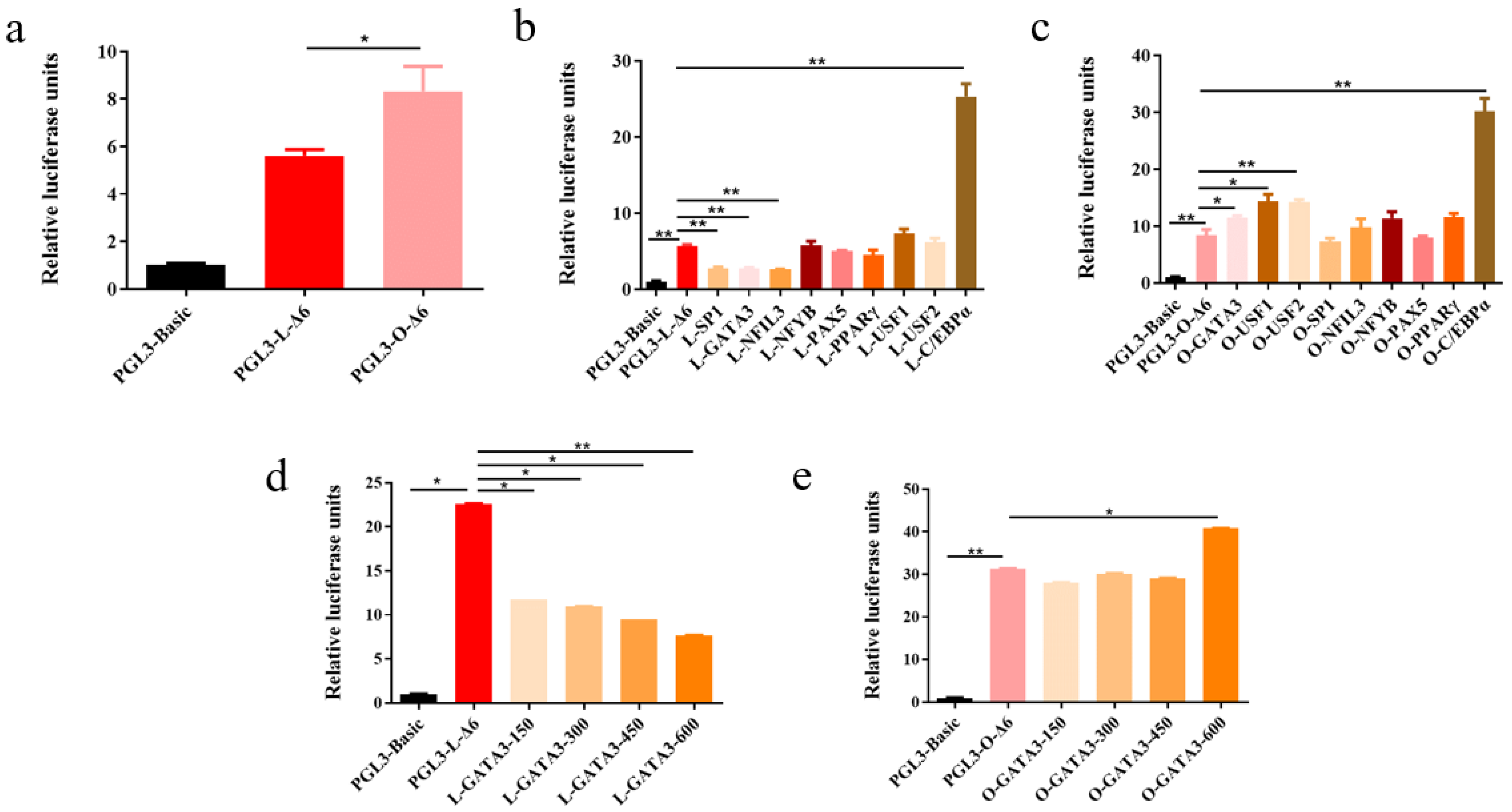
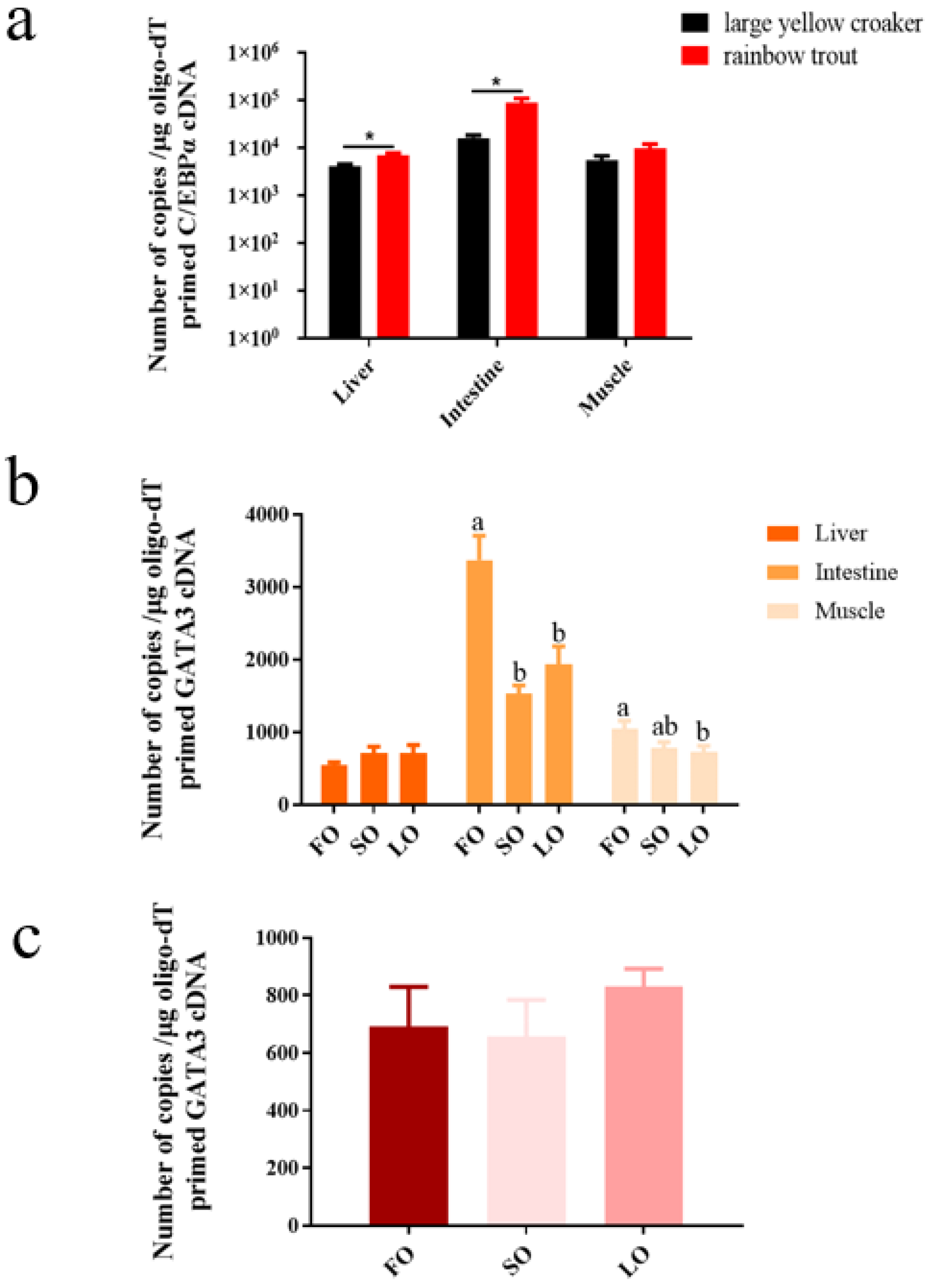
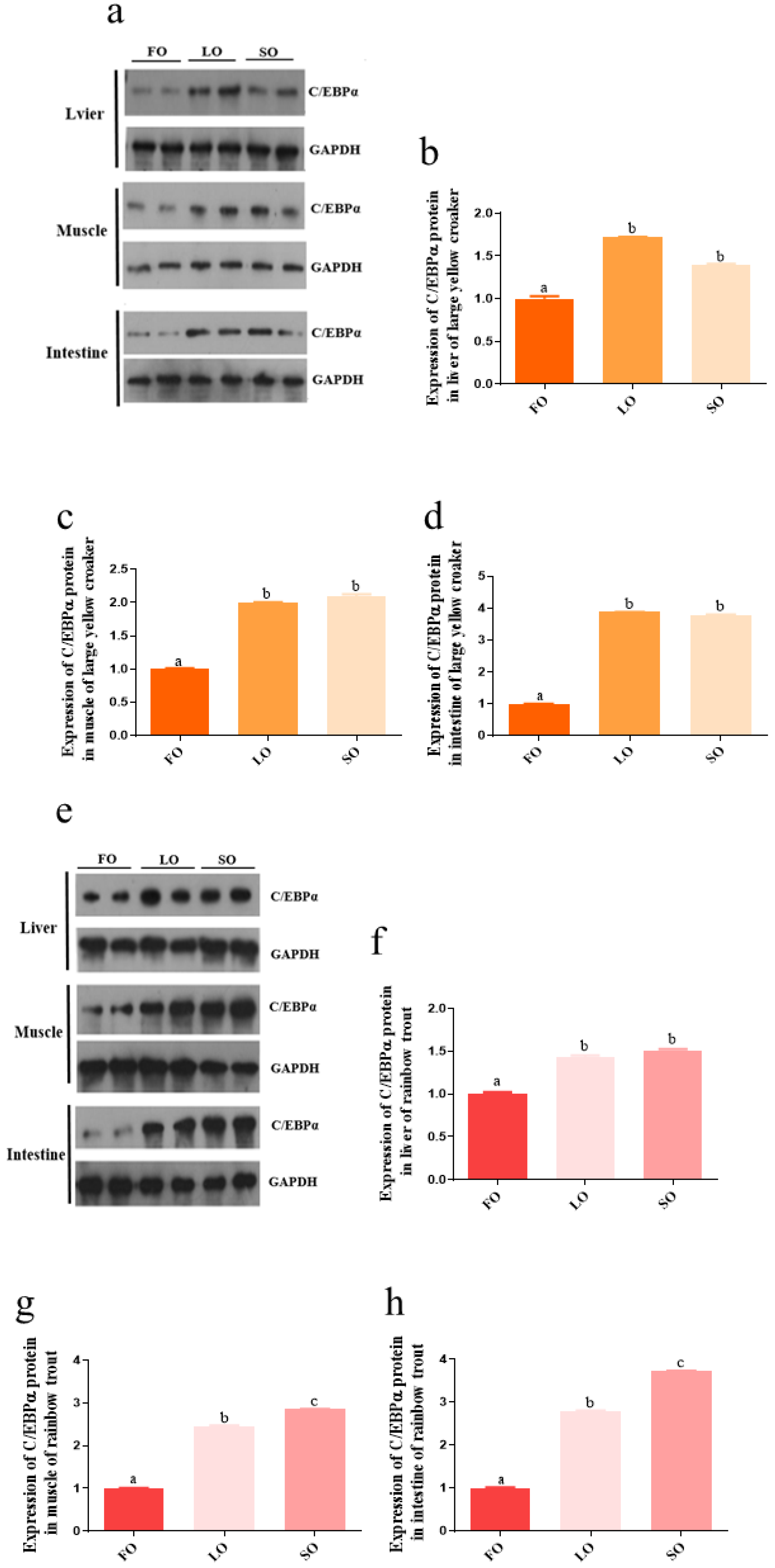

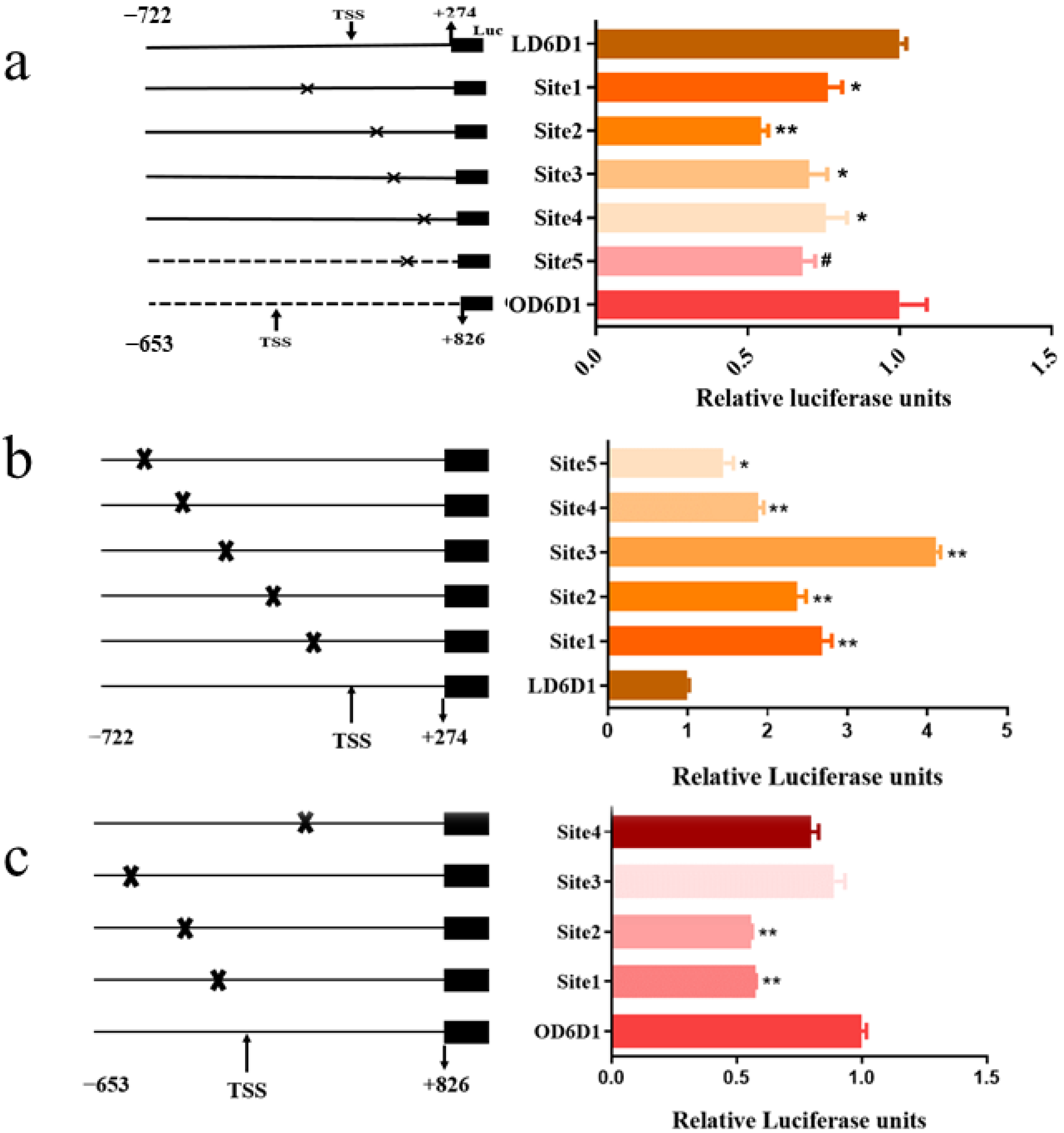


| Fatty Acids | Diet [41] | Liver [41] | Muscle [41] | Intestine | |||||||||||
|---|---|---|---|---|---|---|---|---|---|---|---|---|---|---|---|
| 1FO | 2LO | 3SO | FO | LO | SO | FO | LO | SO | FO | LO | SO | ||||
| 18:2n-6 | 10.16 | 20.31 | 47.92 | 7.16 ± 0.76 a | 14.6 ± 1.59 b | 34.25 ± 1.89 c | 7.80 ± 0.23 a | 13.21 ± 0.28 b | 28.09 ± 0.58 c | 9.07 ± 0.39 a | 22.04 ± 0.94 b | 47.13 ± 0.80 c | |||
| 18:3n-3 | 2.04 | 44.08 | 4.76 | 1.18 ± 0.09 a | 19.25 ± 1.62 b | 2.43 ± 0.27 a | 1.34 ± 0.08 a | 14.90 ± 0.42 c | 2.40 ± 0.08 b | 0.98 ± 0.09 a | 31.29 ± 0.63 c | 3.62 ± 0.62 b | |||
| 20:4n-6 | 0.83 | - | - | 0.47 ± 0.05 b | 0.11 ± 0.02 a | 0.13 ± 0.03 a | 0.76 ± 0.09 b | 0.67 ± 0.08 ab | 0.45 ± 0.06 a | 2.70 ± 0.21 b | 0.45 ± 0.1 a | 0.35 ± 0.08 a | |||
| EPA | 6.4 | - | 0.16 | 2.03 ± 0.13 b | 0.16 ± 0.03 a | 0.14 ± 0.02 a | 3.92 ± 0.09 b | 1.60 ± 0.07 a | 1.34 ± 0.09 a | 4.76 ± 0.14 b | 0.38 ± 0.05 a | 0.61 ± 0.1 a | |||
| DHA | 8.64 | - | - | 2.89 ± 0.37 b | 0.26 ± 0.08 a | 0.16 ± 0.01 a | 6.85 ± 0.46 b | 3.99 ± 0.26 a | 3.01 ± 0.35 a | 14.63 ± 0.43 b | 1.16 ± 0.25 a | 0.83 ± 0.27 a | |||
| EPA + DHA | 15.04 | - | 0.16 | 4.92 ± 0.49 b | 0.41 ± 0.08 a | 0.43 ± 0.15 a | 10.77 ± 0.46 b | 5.58 ± 0.31 a | 4.35 ± 0.44 a | 19.39 ± 0.46 b | 1.77 ± 0.35 a | 1.20 ± 0.31 a | |||
| Fatty Acids | Liver | Muscle | Intestine | ||||||||
|---|---|---|---|---|---|---|---|---|---|---|---|
| 1FO | 2LO | 3SO | FO | LO | SO | FO | LO | SO | |||
| 18:2n-6 | 2.54 ± 0.13 a | 4.55 ± 0.21 b | 9.82 ± 0.63 c | 6.56 ± 0.10 a | 11.24 ± 0.24 b | 24.85 ± 0.58 c | 4.61 ± 0.36 a | 10.88 ± 0.17 b | 19.28 ± 0.11 c | ||
| 18:3n-3 | 0.11 ± 0.06 a | 2.63 ± 0.12 b | 0.28 ± 0.04 a | 1.03 ± 0.01 a | 15.33 ± 0.45 b | 1.37 ± 0.11 a | 0.61 ± 0.01 a | 13.80 ± 0.26 b | 0.96 ± 0.13 a | ||
| 20:4n-6 | 1.43 ± 0.21 a | 1.57 ± 0.44 a | 4.49 ± 0.48 b | 0.92 ± 0.14 b | 0.37 ± 0.03 a | 1.57 ± 0.10 c | 2.00 ± 0.10 a | 1.25 ± 0.27 a | 3.67 ± 0.57 b | ||
| EPA | 1.08 ± 0.23 b | 1.98 ± 0.15 c | 0.18 ± 0.02 a | 2.80 ± 0.14 c | 1.62 ± 0.07 b | 0.53 ± 0.04 a | 1.75 ± 0.17 | 1.38 ± 0.10 | - | ||
| DHA | 17.58 ± 3.24 b | 15.12 ± 0.20 b | 4.58 ± 0.63 a | 12.16 ± 1.67 b | 4.61 ± 0.32 a | 2.88 ± 0.31 a | 16.40 ± 1.65 b | 7.74 ± 0.87 a | 4.03 ± 0.61 a | ||
| EPA + DHA | 18.66 ± 3.46 b | 17.10 ± 0.05 b | 4.76 ± 0.66 a | 14.96 ± 1.81 b | 6.23 ± 0.38 a | 3.41 ± 0.34 a | 18.15 ± 1.73 c | 9.12 ± 0.77 b | 4.19 ± 0.62 a | ||
Publisher’s Note: MDPI stays neutral with regard to jurisdictional claims in published maps and institutional affiliations. |
© 2022 by the authors. Licensee MDPI, Basel, Switzerland. This article is an open access article distributed under the terms and conditions of the Creative Commons Attribution (CC BY) license (https://creativecommons.org/licenses/by/4.0/).
Share and Cite
Sun, J.; Li, J.; Li, Y.; Du, J.; Zhao, N.; Mai, K.; Ai, Q. Regulation of Δ6Fads2 Gene Involved in LC-PUFA Biosynthesis Subjected to Fatty Acid in Large Yellow Croaker (Larimichthys crocea) and Rainbow Trout (Oncorhynchus mykiss). Biomolecules 2022, 12, 659. https://doi.org/10.3390/biom12050659
Sun J, Li J, Li Y, Du J, Zhao N, Mai K, Ai Q. Regulation of Δ6Fads2 Gene Involved in LC-PUFA Biosynthesis Subjected to Fatty Acid in Large Yellow Croaker (Larimichthys crocea) and Rainbow Trout (Oncorhynchus mykiss). Biomolecules. 2022; 12(5):659. https://doi.org/10.3390/biom12050659
Chicago/Turabian StyleSun, Jie, Jingqi Li, Yongnan Li, Jianlong Du, Nannan Zhao, Kangsen Mai, and Qinghui Ai. 2022. "Regulation of Δ6Fads2 Gene Involved in LC-PUFA Biosynthesis Subjected to Fatty Acid in Large Yellow Croaker (Larimichthys crocea) and Rainbow Trout (Oncorhynchus mykiss)" Biomolecules 12, no. 5: 659. https://doi.org/10.3390/biom12050659





